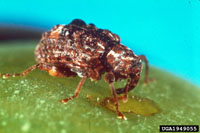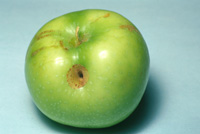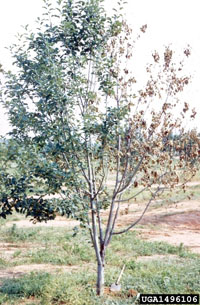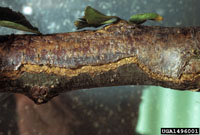Extension > Garden > Diagnose a problem > What's wrong with my plant? > Fruit > Apple > Fruit drop
Apples > Fruit > Fruit drop
1 of 3
Plum Curculio
Conotrachelus nenuphar
- Fruit can drop prematurely
- Adult weevils lay eggs in the apple resulting in distinctive crescent shaped tan spots on the apples
- Adult weevil is small (1/5" in length), dark brown with whitish-gray patches, bumps on the wings, and a distinctive downward-curved snout
- Mature larvae are yellow-white, ¼" long, and c-shaped (rarely seen)
- Adults active in early spring (during bloom)
- More information on Plum Curculio
2 of 3
Obliquebanded Leafroller
Choristoneura rosaceana
- Early season larvae feed inside bud clusters and developing fruit, resulting in fruit drop or corky scars on the fruit
- Early season larvae feed on the undersurface of a leaf along the midrib or other large vein
- Late season larvae can scar the fruit
- Green egg masses are laid on the upper surface of the leaves
- Adult moth is reddish-brown with brown bands on the wings; larvae are yellow-green and 1” in length when mature
- More information on Obliquebanded Leafroller
3 of 3
White Rot
Botryosphaeria dothidea
- Sunken brown spots on fruit, can grow to rot part or all of fruit
- Fruit rot is soft, watery and extends to the core of the apple
- Small blister like spots on branches exude, watery fluid
- Branch infections grow to cracked, flakey, orange canker
- Leaves on girdled branches wilt, die and turn brown
- More information on White rot












